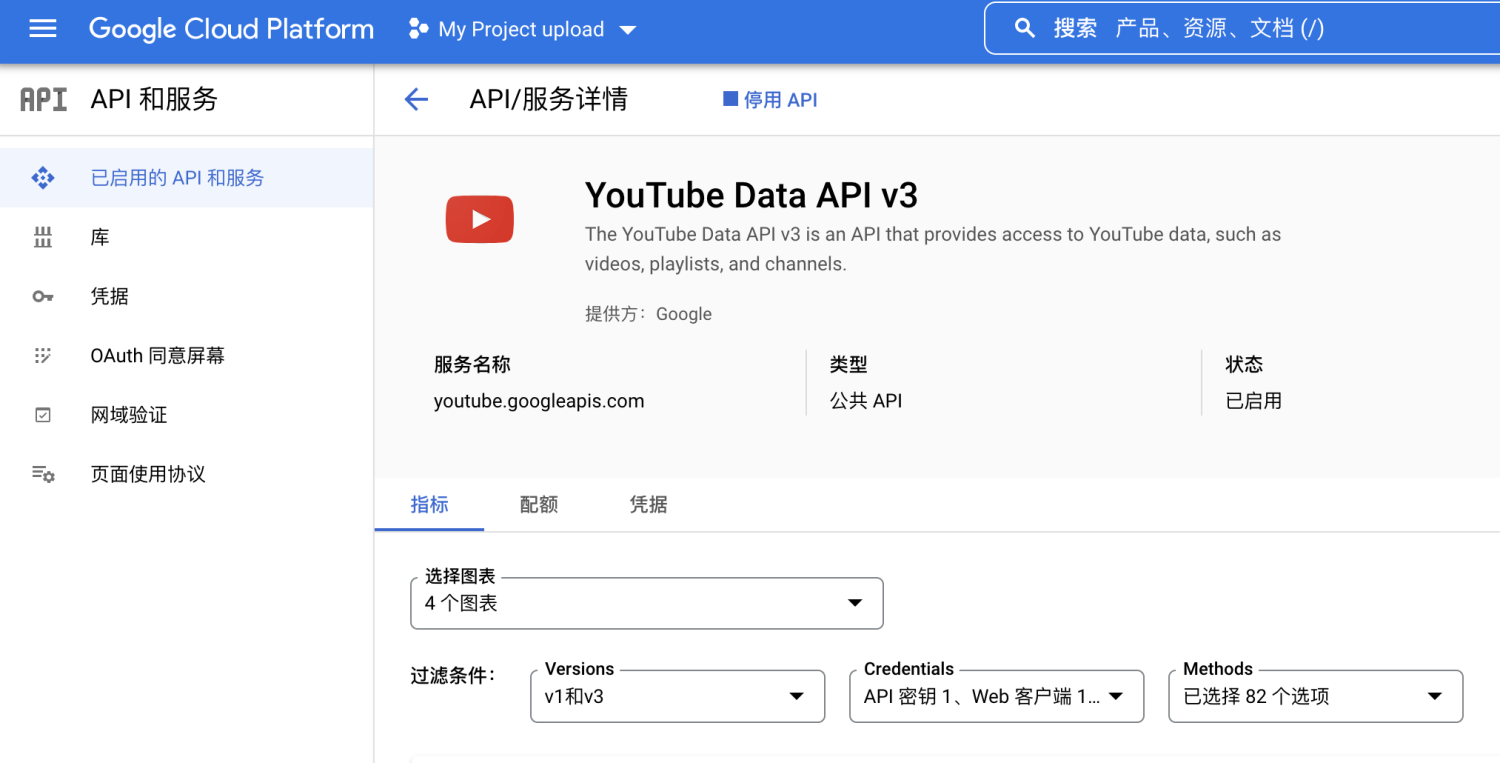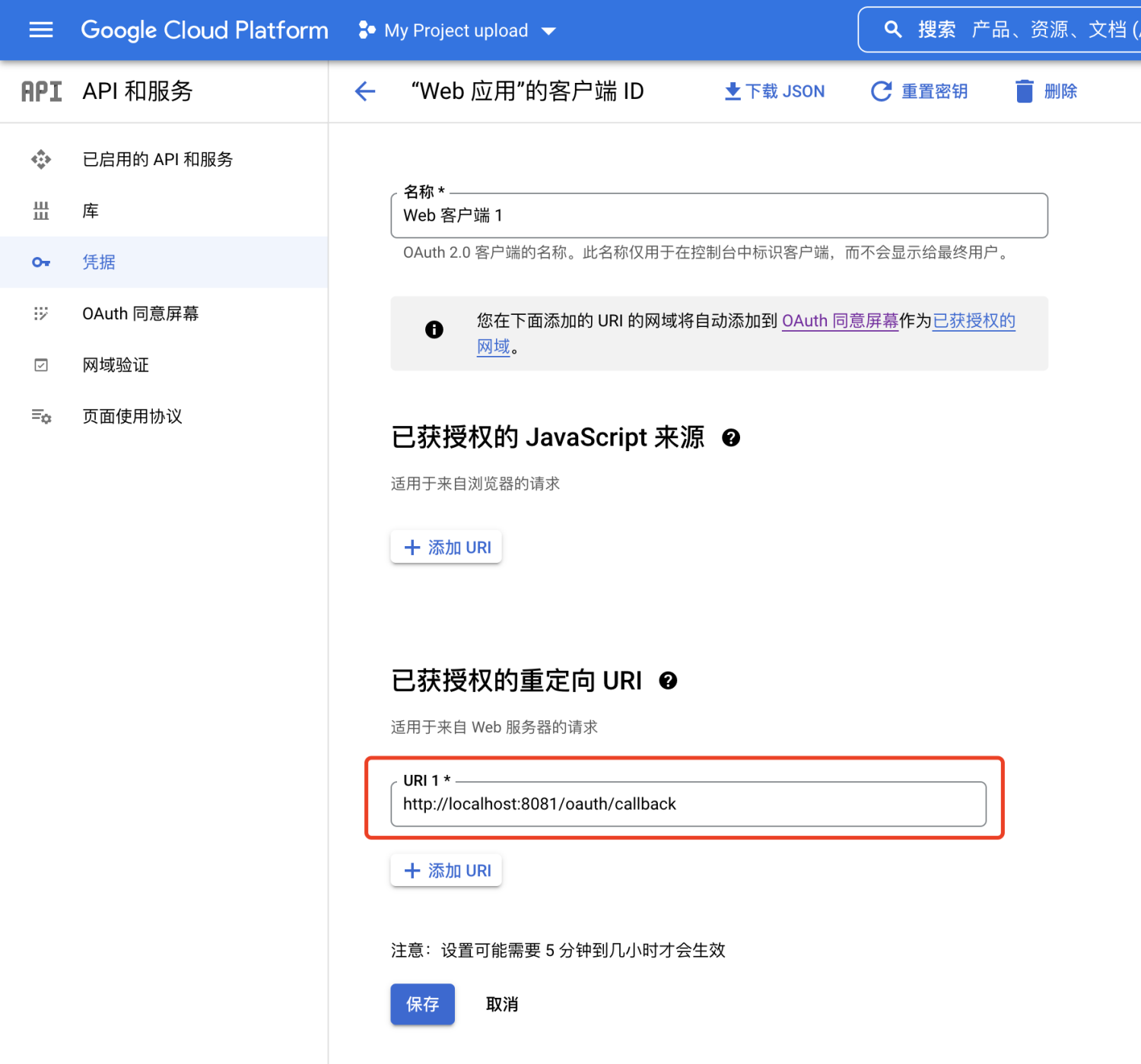文档
启用 api 和服务、申请凭据 等
包括相关接口的调用方式及参数、可以实操运行
步骤
1. 申请 api 服务
首先你需要在自己创建的项目里面开启 google+ 和 youtube 两个 api


2. 创建 oauth 凭证
我们一共有两个身份凭据,一个是 API key,他的使用场景是:比如取得一些公开信息的时候,你是不需要用户授权访问的,访问 youtube 公开的 channel 就是这样
另外一个是 oauth2.0 认证,比如:视频上传视频、拉取个人视频等信息

创建的时候应用类型可以选择 “web 应用”

不过 web 类型需要提供一个重定向 URI,不过只需要可以调通返回 status:200 就可以

3. 授权账号
在第一次操作时,需要通过 web 获取 token;然后把 token 保存到文件中,后面定期根据 refresh_token 来更新 token,后期基本就可以完全通过 API 操作了
第一次 web 操作时,需要对具体账号进行授权,才可以调用接口,所以要在 Oauth 同意屏幕中把账号填进去


4. 下载 json 文件

代码
upload_youtube_video
package main
import (
"flag"
"fmt"
"log"
"os"
"strings"
"time"
"google.golang.org/api/youtube/v3"
)
var (
filename = flag.String("filename", "", "Name of video file to upload")
title = flag.String("title", "Test Title", "Video title")
description = flag.String("description", "Test Description", "Video description")
category = flag.String("category", "22", "Video category")
keywords = flag.String("keywords", "", "Comma separated list of video keywords")
privacy = flag.String("privacy", "unlisted", "Video privacy status")
)
func main() {
flag.Parse()
if *filename == "" {
log.Fatalf("You must provide a filename of a video file to upload")
}
client := getClient(youtube.YoutubeUploadScope)
service, err := youtube.New(client)
if err != nil {
log.Fatalf("Error creating YouTube client: %v", err)
}
upload := &youtube.Video{
Snippet: &youtube.VideoSnippet{
Title: *title,
Description: *description,
CategoryId: *category,
},
Status: &youtube.VideoStatus{PrivacyStatus: *privacy},
}
// The API returns a 400 Bad Request response if tags is an empty string.
if strings.Trim(*keywords, "") != "" {
upload.Snippet.Tags = strings.Split(*keywords, ",")
}
startTime := time.Now()
call := service.Videos.Insert([]string{"snippet", "status"}, upload)
file, err := os.Open(*filename)
defer file.Close()
if err != nil {
log.Fatalf("Error opening %v: %v", *filename, err)
}
response, err := call.Media(file).Do()
duration := time.Since(startTime)
fmt.Printf("duration:%+v\n", duration)
//handleError(err, "")
fmt.Printf("Upload successful! Video ID: %v\n", response.Id)
}
oauth2
package main
import (
"encoding/json"
"fmt"
"io/ioutil"
"log"
"net"
"net/http"
"net/url"
"os"
"os/exec"
"os/user"
"path/filepath"
"runtime"
"golang.org/x/net/context"
"golang.org/x/oauth2"
"golang.org/x/oauth2/google"
)
// This variable indicates whether the script should launch a web server to
// initiate the authorization flow or just display the URL in the terminal
// window. Note the following instructions based on this setting:
// * launchWebServer = true
// 1. Use OAuth2 credentials for a web application
// 2. Define authorized redirect URIs for the credential in the Google APIs
// Console and set the RedirectURL property on the config object to one
// of those redirect URIs. For example:
// config.RedirectURL = "http://localhost:8090"
// 3. In the startWebServer function below, update the URL in this line
// to match the redirect URI you selected:
// listener, err := net.Listen("tcp", "localhost:8090")
// The redirect URI identifies the URI to which the user is sent after
// completing the authorization flow. The listener then captures the
// authorization code in the URL and passes it back to this script.
// * launchWebServer = false
// 1. Use OAuth2 credentials for an installed application. (When choosing
// the application type for the OAuth2 client ID, select "Other".)
// 2. Set the redirect URI to "urn:ietf:wg:oauth:2.0:oob", like this:
// config.RedirectURL = "urn:ietf:wg:oauth:2.0:oob"
// 3. When running the script, complete the auth flow. Then copy the
// authorization code from the browser and enter it on the command line.
const launchWebServer = false
const missingClientSecretsMessage = `
Please configure OAuth 2.0
To make this sample run, you need to populate the client_secrets.json file
found at:
%v
with information from the
For more information about the client_secrets.json file format, please visit:
https://developers.google.com/api-client-library/python/guide/aaa_client_secrets
`
// getClient uses a Context and Config to retrieve a Token
// then generate a Client. It returns the generated Client.
func getClient(scope string) *http.Client {
ctx := context.Background()
b, err := ioutil.ReadFile("client_secret.json")
if err != nil {
log.Fatalf("Unable to read client secret file: %v", err)
}
// If modifying the scope, delete your previously saved credentials
// at ~/.credentials/youtube-go.json
config, err := google.ConfigFromJSON(b, scope)
if err != nil {
log.Fatalf("Unable to parse client secret file to config: %v", err)
}
// Use a redirect URI like this for a web app. The redirect URI must be a
// valid one for your OAuth2 credentials.
//config.RedirectURL = "http://localhost:8090"
// Use the following redirect URI if launchWebServer=false in oauth2.go
//config.RedirectURL = "urn:ietf:wg:oauth:2.0:oob"
cacheFile, err := tokenCacheFile()
if err != nil {
log.Fatalf("Unable to get path to cached credential file. %v", err)
}
tok, err := tokenFromFile(cacheFile)
//err = fmt.Errorf("test")
if err != nil {
authURL := config.AuthCodeURL("state-token", oauth2.AccessTypeOffline)
if launchWebServer {
fmt.Println("Trying to get token from web")
tok, err = getTokenFromWeb(config, authURL)
} else {
fmt.Println("Trying to get token from prompt")
tok, err = getTokenFromPrompt(config, authURL)
}
if err == nil {
saveToken(cacheFile, tok)
}
}
return config.Client(ctx, tok)
}
// startWebServer starts a web server that listens on http://localhost:8080.
// The webserver waits for an oauth code in the three-legged auth flow.
func startWebServer() (codeCh chan string, err error) {
listener, err := net.Listen("tcp", "localhost:8090")
if err != nil {
return nil, err
}
codeCh = make(chan string)
go http.Serve(listener, http.HandlerFunc(func(w http.ResponseWriter, r *http.Request) {
code := r.FormValue("code")
codeCh <- code // send code to OAuth flow
listener.Close()
w.Header().Set("Content-Type", "text/plain")
fmt.Fprintf(w, "Received code: %v\r\nYou can now safely close this browser window.", code)
}))
return codeCh, nil
}
// openURL opens a browser window to the specified location.
// This code originally appeared at:
// http://stackoverflow.com/questions/10377243/how-can-i-launch-a-process-that-is-not-a-file-in-go
func openURL(url string) error {
var err error
switch runtime.GOOS {
case "linux":
err = exec.Command("xdg-open", url).Start()
case "windows":
err = exec.Command("rundll32", "url.dll,FileProtocolHandler", "http://localhost:4001/").Start()
case "darwin":
err = exec.Command("open", url).Start()
default:
err = fmt.Errorf("Cannot open URL %s on this platform", url)
}
return err
}
// Exchange the authorization code for an access token
func exchangeToken(config *oauth2.Config, code string) (*oauth2.Token, error) {
tok, err := config.Exchange(oauth2.NoContext, code)
if err != nil {
log.Fatalf("Unable to retrieve token %v", err)
}
return tok, nil
}
// getTokenFromPrompt uses Config to request a Token and prompts the user
// to enter the token on the command line. It returns the retrieved Token.
func getTokenFromPrompt(config *oauth2.Config, authURL string) (*oauth2.Token, error) {
var code string
fmt.Printf("Go to the following link in your browser. After completing "+
"the authorization flow, enter the authorization code on the command "+
"line: \n%v\n", authURL)
if _, err := fmt.Scan(&code); err != nil {
log.Fatalf("Unable to read authorization code %v", err)
}
fmt.Println(authURL)
return exchangeToken(config, code)
}
// getTokenFromWeb uses Config to request a Token.
// It returns the retrieved Token.
func getTokenFromWeb(config *oauth2.Config, authURL string) (*oauth2.Token, error) {
codeCh, err := startWebServer()
if err != nil {
fmt.Printf("Unable to start a web server.")
return nil, err
}
err = openURL(authURL)
if err != nil {
log.Fatalf("Unable to open authorization URL in web server: %v", err)
} else {
fmt.Println("Your browser has been opened to an authorization URL.",
" This program will resume once authorization has been provided.\n")
fmt.Println(authURL)
}
// Wait for the web server to get the code.
code := <-codeCh
return exchangeToken(config, code)
}
// tokenCacheFile generates credential file path/filename.
// It returns the generated credential path/filename.
func tokenCacheFile() (string, error) {
usr, err := user.Current()
if err != nil {
return "", err
}
tokenCacheDir := filepath.Join(usr.HomeDir, ".credentials")
os.MkdirAll(tokenCacheDir, 0700)
return filepath.Join(tokenCacheDir,
url.QueryEscape("youtube-go.json")), err
}
// tokenFromFile retrieves a Token from a given file path.
// It returns the retrieved Token and any read error encountered.
func tokenFromFile(file string) (*oauth2.Token, error) {
f, err := os.Open(file)
if err != nil {
return nil, err
}
t := &oauth2.Token{}
err = json.NewDecoder(f).Decode(t)
defer f.Close()
return t, err
}
// saveToken uses a file path to create a file and store the
// token in it.
func saveToken(file string, token *oauth2.Token) {
fmt.Println("trying to save token")
fmt.Printf("Saving credential file to: %s\n", file)
f, err := os.OpenFile(file, os.O_RDWR|os.O_CREATE|os.O_TRUNC, 0600)
if err != nil {
log.Fatalf("Unable to cache oauth token: %v", err)
}
defer f.Close()
json.NewEncoder(f).Encode(token)
}
refresh_token
package main
import (
"context"
"encoding/json"
"fmt"
"golang.org/x/oauth2"
"io/ioutil"
"log"
)
func main() {
err := refreshToken()
fmt.Println("refreshToken result:", err)
}
func newConf() *oauth2.Config {
b, err := ioutil.ReadFile("client_secret.json")
if err != nil {
log.Fatalf("Unable to read client secret file: %v", err)
}
type cred struct {
ClientID string `json:"client_id"`
ClientSecret string `json:"client_secret"`
RedirectURIs []string `json:"redirect_uris"`
AuthURI string `json:"auth_uri"`
TokenURI string `json:"token_uri"`
}
var j struct {
Web *cred `json:"web"`
Installed *cred `json:"installed"`
}
if err = json.Unmarshal(b, &j); err != nil {
log.Fatalf("json Unmarshal fail: %v", err)
}
return &oauth2.Config{
ClientID: j.Web.ClientID,
ClientSecret: j.Web.ClientSecret,
RedirectURL: j.Web.RedirectURIs[0],
Scopes: []string{"scope1", "scope2"},
Endpoint: oauth2.Endpoint{
AuthURL: j.Web.AuthURI,
TokenURL: j.Web.TokenURI,
},
}
}
func refreshToken() error {
cacheFile, err := tokenCacheFile()
if err != nil {
log.Fatalf("Unable to get path to cached credential file. %v", err)
}
tok, err := tokenFromFile(cacheFile)
if err != nil {
log.Fatalf("cacheFile not exit")
}
//ts := httptest.NewServer(http.HandlerFunc(func(w http.ResponseWriter, r *http.Request) {
// w.Header().Set("Content-Type", "application/json")
// w.Write([]byte(`{"access_token":"ACCESS_TOKEN", "scope": "user", "token_type": "bearer", "refresh_token": "NEW_REFRESH_TOKEN"}`))
// return
//}))
//defer ts.Close()
conf := newConf()
tkr := conf.TokenSource(context.Background(), &oauth2.Token{RefreshToken: tok.RefreshToken})
tk, err := tkr.Token()
if err != nil {
return nil
}
saveToken(cacheFile, tk)
//if err != nil {
// t.Errorf("got err = %v; want none", err)
// return
//}
//if want := "NEW_REFRESH_TOKEN"; tk.RefreshToken != want {
// t.Errorf("RefreshToken = %q; want %q", tk.RefreshToken, want)
//}
return nil
}